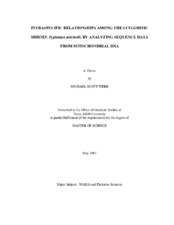| dc.description.abstract | Intraspecific relationships among the anchialine cave shrimp Typhlatya mitchelli were examined by sequencing a total of 1505 bp from portions of three mitochondrial DNA genes. Cytochrome b, cytochrome oxidase I, and 16S rRNA were partially sequenced and analyzed for specimens from six different cenotes (water-filled caves) across the Yucatan Peninsula, Mexico. The conspecific Typhlatya pearsei that is sympatric with T. mitchelli was also sequenced and used as the outgroup. Comparisons among specimens of T. mitchelli yielded low sequence divergence values (0-1.7%), with the majority being less than 0.4%. Phylogenetic tree topologies reconstructed with neighbor-joining, maximum likelihood, and maximum parsimony were in agreement in regards of the resolution of deep branches. Also, there was no obvious geographic differentiation among the majority of T. mitchelli samples, with the exception of specimens from Cenote San Antonio Chiich (Yokdzonot, Yucatan, Mexico) which all clustered into an extremely well supported monophyletic group. The level of differentiation of this group, together with the nearly total absence of differentiation among T. mitchelli from distant cave systems, suggests that this is an Evolutionary Significant Unit (ESU), which may correspond to a new species. This unidentified Typhlatya from Cenote San Antonio Chiich was helpful in establishing a period in which the epigean ancestor colonized the cenotes. Based on pairwise distance data and previously published shrimp molecular clocks (Baldwin et al., 1998), T. mitchelli and the putative new Typhlatya species last shared a common ancestor between 3-5 million years ago (mya), during the mid-Pliocene era, while T. mitchelli and T. pearsei was approximately 7-10 mya (middle to late Miocene). The ancestor to T. mitchelli and the unidentified Typhlatya species abandoned its shallow coastal water existence in the early Pliocene and eventually expanded its range across the peninsula. Approximately 4 mya, Cenote San Antonio Chiich became isolated from the remaining gene pool thereby halting gene flow. As the regional water table fluctuated in response to the rise and fall of Pleistocene sea levels, T. mitchelli actively colonized the peninsula. The discovery of a single, continuous subterranean freshwater system provides for a better understanding of anchialine biogeography within the Yucatan Peninsula. | en |


